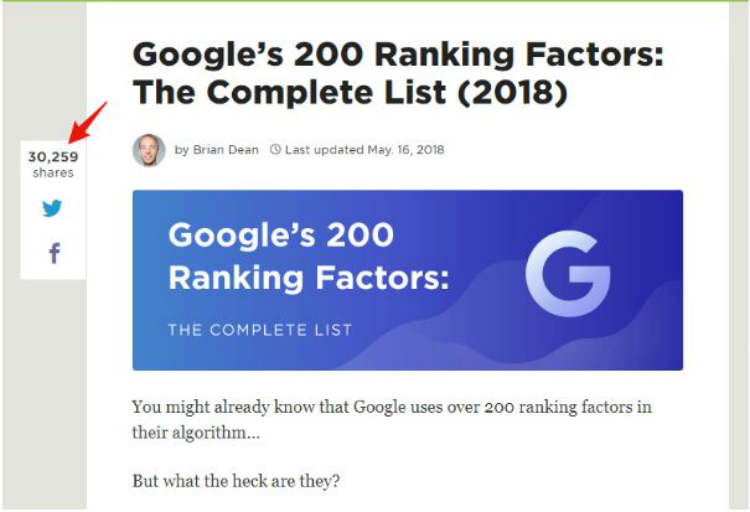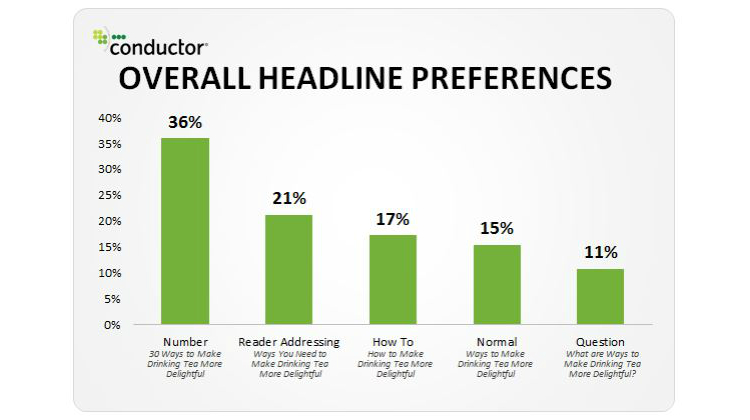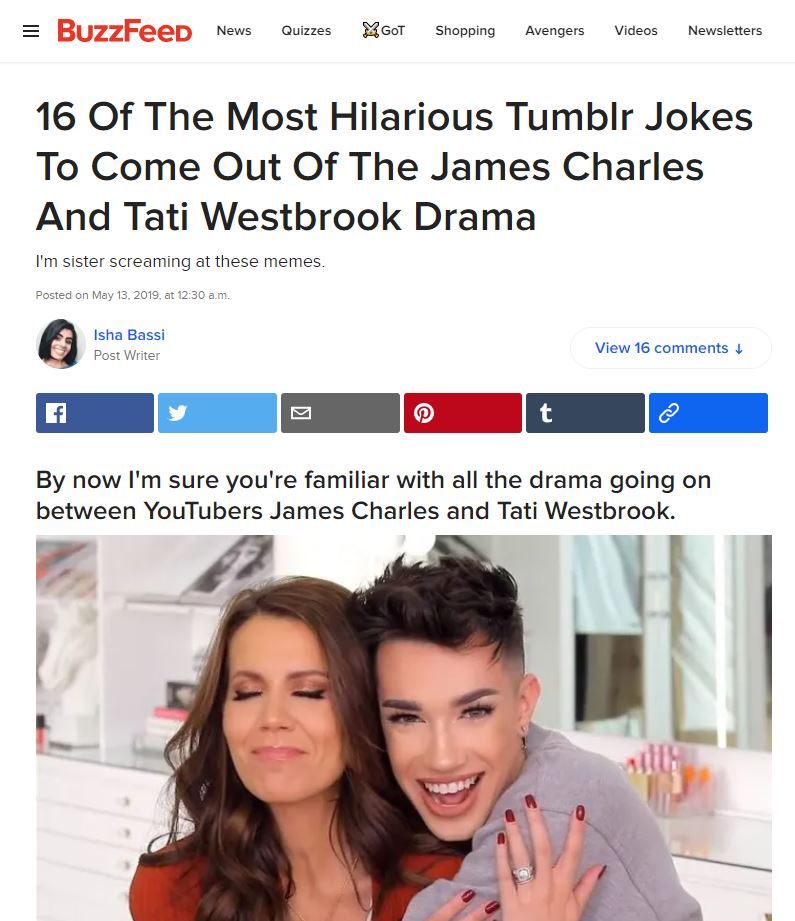If you ask anybody that is a blogger or creates some form of content online, they will agree with me when I said that attention-grabbing headlines are one of the most essential blogging skills you need.
In fact, Copyblogger stated that only 2 out of 10 people who read your headline would consume your content.

Buzzfeed cares a lot about headlines and so should you.
Let’s take a little look at some of Buzzfeed’s headlines tropes that can help you bring in more visitors.
Before we get into the example, I would like to remind those from the email course and give those who aren’t a task.
I want you to come up with five headlines that target keywords within your niche.
It could be five new headlines for existing content or 5 headlines for content in the future.
Also, try out the plugins at the bottom of the guide that helps you with your headlines by A/B testing your headlines against each other.
What Makes A Headline Go Viral?
After reading an article on Entrprenuer.com, I found out that UCLA concluded in a study that “buzz” is associated with specific regions of the brain, which means that to feel connected with others, we like to share content that is either useful, entertaining, or inspirational.
As humans, we have necessary and complicated needs, and except for the basic needs (such as food, drink, and shelter), our primary goal is to get attention/validation from others.
As social creatures, we’ve evolved to the point where most of the things we think about in our conscious mind are directly related to how other’s would view us.
Even down to the content we share online.
Why Content Goes Viral
Viral content is a touchy subject for some, but to understand why content goes viral, we need to look at why people share content online.
Using myself as an example, I share content online (content that wasn’t created by me), to spark conversation between my loved ones and me.
For example, when sharing something controversial, the goal is to spark conversation and let others know that I have been keeping up with current news/trends.
We share to get noticed while reflecting who we are as a person.
So, what type of headlines are most likely to get shared by others online?
Types Of Headlines Most Likely To Get A lot of Attention
Using Buzzfeed, I want to look at a few examples of headlines that they’ve used over the years to grow their audience.
Let’s get into it.
1. Using Numbers Helps Give Concrete Facts
Example number #1: 18 Times Tumblr Was The Punniest Place On The Entire Goddamn Internet.
We all know that list posts are a big hit online.
Numbers give a clear indication of how many things will be covered in this article.
It also helps people understand how in-depth the content is.
For example, if you wanted to learn more about SEO you would more likely want to read “200 Google Ranking factors to Rank,” rather than reading “5 Ranking Factors in SEO.”
Wait don’t people have a shorter attention span these days?

Take a look at Brian Dean’s article on exactly that. His post (at the time of writing this) has over 30,000 shares.
You do not even need to make a list post to use numbers.
If you found an SEO strategy that boosted your monthly visitors by 67% then use that.
You could have a title like “How I Boosted My Monthly Visitors By 67%.”
Another Example

According to a study made by Moz, headlines with numbers in it get at least a 36% increase in click-throughs, which is more than:
- Reader Addressing Headlines (21%)
- How to Headlines (17%)
- Regular Headlines (15%)
- Question Type Headlines (11%)
People like numbers because they indicate proof & authority with that article.
Another example of this would be headlines like the one above.
Neil Patel published an article in April called “How to Grow Your Social Fans by 400% With User-Generated Content.”
That is a huge claim.
If you had 1,000 followers on social media, that means that this article could help you reach 4,000 new followers.
Once people see that, they will be more likely to click the post to check it out.
That is why that article is currently sitting as 345 Facebook shares alone.
Note: Do not use headlines with huge claims unless you can back up that claim. If you clickbait people then it will have the opposite effect on your “Authority.”
The last tip for numbers is step-by-step guides.
LiveScience published an article in which they stated that the human brain could only process five to nine things for short-term memory recall.
That means that processing over ten things can become overwhelming.
For this reason, I would suggest only having five to nine steps in your guides.
In fact, even if you are doing a list post of 200 items, I would recommend picking the 5 – 9 best tips and adding them at the top of your article.
2. Why you should use emotional words to help your readers
Example number #2: A Reporter Asked Rihanna If She Would Be Attending The Royal Wedding And She Replied In The Best Way.
Okay, this title doesn’t help someone with a problem but it invokes curiosity.
By using emotional words in your headlines, you will get a ton of clicks.
Instead of just having “A Reporter Asked Rihanna if She Would Be Attending The Royal Wedding,” as their headline, they invoked curiosity into their readers by adding “And She Replied in The Best Way.”
Using SEO as our example, you could have a headline like this:
“How Anthony’s Backlink Strategy Shocked Me.”
I could use something like “Backlink Strategy: How to Get Better Backlinks,” which isn’t bad but it doesn’t create any emotion.
Another Example
I used curiosity as an example for creating emotion; however, that isn’t the only emotion.
If you use Coschedule’s Headline Analyzer, you will notice how much they talk using “Power Words.”

(Source: Coschedule Power Words )
They are essential to any headline, and if you look carefully, you will notice power words in almost all of the examples used in this article.
Even in the headline for this article has words such as:
- How
- To
- Improve
Remember you do not only want people to land on your page and read your content, but you also want them to learn and feel the emotions behind your words.
Coschedule has an article talking about the psychology of social sharing; I would highly recommend that you read it.
3. Focus on showing not telling
Example number #3: 14 YouTube Channels You Need To Know If You Want To Work Out For Free.
This headline features two different tropes.
Can you see the other one?
When people are on social media, they not there to consume your content. They’re there to connect with their friends, family and other people on the platform.
If you want to capture their attention, you will need to find a way to help with something where they didn’t even know they needed the help.
I wrote a guide on setting up your Google Search Console with WordPress, and my headline for that is “How to Set Up Google Search Console With WordPress (2019 Update).”
If you’re unsure on how to set that up, seeing my headline will let you know that I’m here with a step-by-step guide that you can use to properly set up Google Search Console.
The sad reality is that people do not care about you or your website. They only care about how you can help them.
So remember when creating the headlines you want to help your target audience.
Another Example
As humans, we are visual creatures by nature. That’s why we came up with the expression “Actions speak louder than words.”
I could sit at my desk and create a 3,000-word article about how you can make $1,000,000 by next week, but if I can’t show you how to do that, then it’s merely a scam.
Headlines are the first (and most cases the last) thing that people will see when looking through your content.
It’s vital that you give them a reason to stay.
In OptinMonster’s case, they wanted to show their readers how to increase their blog traffic with 25 strategies that they put together.
Instead of telling them that they can increase their traffic, they wanted to show them how much their reader base can be improved.
OptinMonster’s Headline: “25 Proven Strategies to Increase Your Blog’s Traffic by 1064%”
4. Use headlines that spell out your content
Example number #4: Literally Just 21 Funny Tweets From This Year’s Eurovision.
This headline is perfect for this last tip.
Sometimes you can just say what is in your content as a headline.
If you read the blog that this title is connected to, you will see that it is just 21 funny tweets from the Eurovision.
If you remember earlier in this lesson, I was talking about Brian Dean’s article on Google ranking factors.
The title was merely what the content had to offer to you. “200 Google Ranking Factors.”
Another Example
In some cases, your content can do all the talking for you.
Your goal is to get more and more people to read your content.
If the article is good enough (which it should be), you can use the main benefit of your content as your headline.
Like I mentioned earlier, only use specific tactics if you can back it up. It will negatively impact you if you’re creating headlines like:
- 300 Awesome SEO Strategies
- How I Invested $3 Million into Social Media & Got $10 Million Back
- Shocking Things This Celebrity Said About This Celebrity
If you’re not able to back up those claims with facts.
5. Using Current News/Trends to Spark Emotion
Example #5: 16 Of The Most Hilarious Tumblr Jokes To Come Out Of The James Charles And Tati Westbrook Drama
This example is going to be a shorter one but similar to how using emotional words can grab people’s attention, using current news/trends can be even more effective.

Personally, I don’t follow James Charles, however, recently he has caused a lot of drama around himself with videos exposing his actions.
Everybody is jumping and giving their two cents.
Though for most fans, this is a horrible situation to see one of your favorite creators go through, for others, it’s funny.
A chance to make light on a dark situation.
Buzzfeed uses that emotion to grab people’s attention by collecting memes that have surfaced and put them into one location.
For most people active on social media, these type of articles is the easiest to make.
By either showcasing a bunch of stuff (related to a current hot topic) or giving your opinion on that topic, people will naturally consume and share your content (no matter what side they’re on).
What to Take From This Guide
The one thing that I want you to leave here understanding is that headlines are crucial to your consumer growth.
It will be hard to consistently come up with headlines that incorporate all of the types that we have discussed today, but if you try to use a combination of 2 – 3 of them, then you will have a compelling headline.
If you use the headline analyzer from Coshedule, they would recommend using headlines with a score above 70.
Personally, I would recommend to split test your headlines and track which type of headlines are best for your business.
What works for Buzzfeed or Business Insider may not work for your brand.
Extra Note: You can use a different headline for social media & your website than you do for your Google result. Take that into account when optimizing your content for SEO.
I can only give you the guides and tutorials.
It’s up to you whether or not they work.
You have to keep testing headlines against each other and triple down on what works.
Feel free to comment down below if you have any questions or would like to add to this guide on copywriting headline examples; I always get back to those of you who leave a comment.
Here are all the tools I would recommend to help you write better headlines.
- Hemingway Editor App
- The Readability Test Tool
- CoSchedule’s Headline Analyzer
- Thrive Headline Optimizer
Finishing this off, what was your favorite example?
Also, how do you plan on using some of these tips for your own article?
Let me know in the comments below.
About the Author

Founder of BloggerXL, Anthony helps solopreneurs (who are relatively new) become better at generating traffic by helping you build new content marketing skills and systemizing your content creation.


